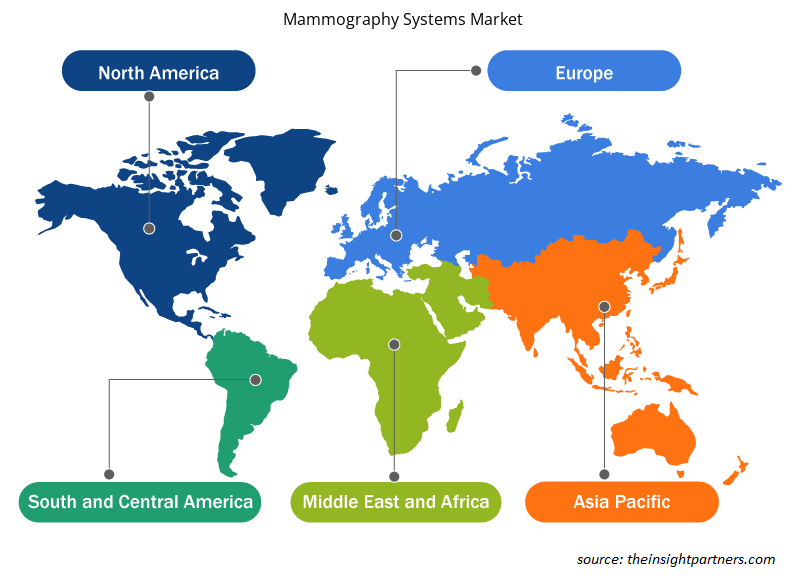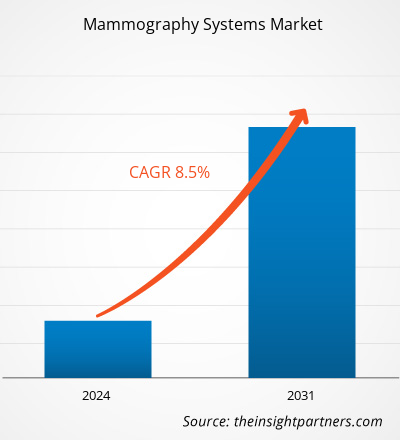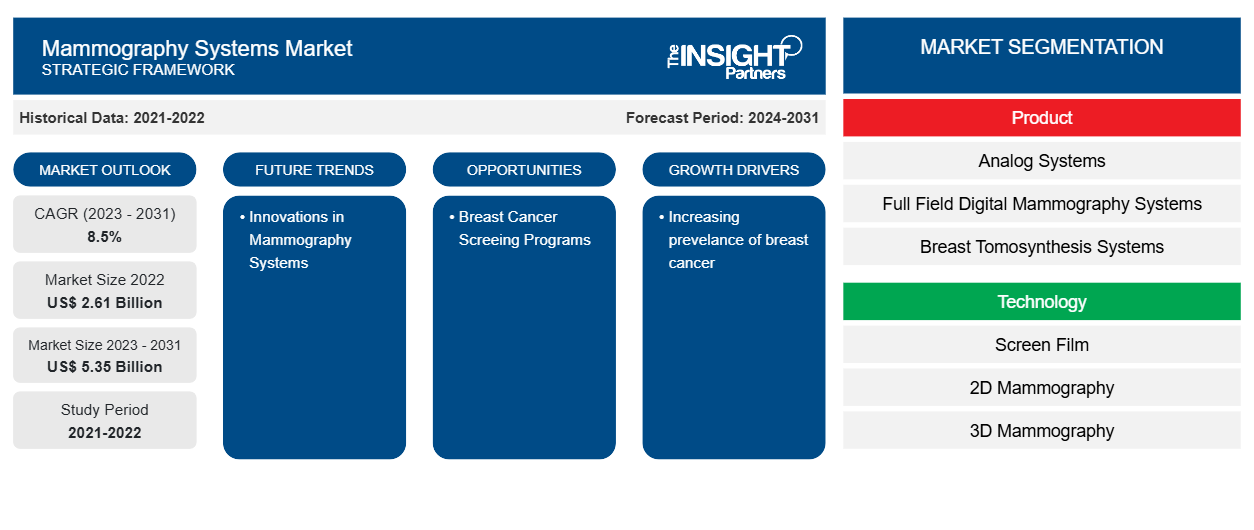من المتوقع أن يصل حجم سوق أنظمة التصوير الشعاعي للثدي إلى 5.35 مليار دولار أمريكي بحلول عام 2031 من 2.61 مليار دولار أمريكي في عام 2022. ومن المتوقع أن يسجل السوق معدل نمو سنوي مركب بنسبة 8.5٪ في الفترة 2023-2031. أدى الابتكار المتزايد في أنظمة التصوير الشعاعي للثدي والتعاون بين اللاعبين في السوق إلى إطلاق منتجات جديدة من المرجح أن تظل اتجاهات رئيسية في سوق أنظمة التصوير الشعاعي للثدي.
تحليل سوق أنظمة التصوير الشعاعي للثدي
إن انتشار سرطان الثدي آخذ في الازدياد في جميع أنحاء العالم مما أدى إلى زيادة الطلب على أنظمة التصوير الشعاعي للثدي للتشخيص. بعض الأعراض الشائعة لسرطان الثدي هي ظهور حلمات مقلوبة، وتغيرات في شكل الثدي، وتطور كتل في الثدي، أو بقعة حمراء أو متقشرة من الجلد، أو حلمات مؤلمة. وفقًا لتقرير منظمة سرطان الثدي لعام 2023، فإن سرطان الثدي يمثل 12.5٪ من إجمالي حالات السرطان المبلغ عنها عالميًا. بالإضافة إلى ذلك، فإن حوالي 30٪ من حالات السرطان التي تم تشخيصها حديثًا بين النساء هي سرطان الثدي. وفقًا لنفس المصدر، من المتوقع تشخيص 2800 حالة سرطان ثدي جديدة لدى الرجال خلال عام 2023. لذلك، من المتوقع أن يؤدي الانتشار المتزايد عالميًا لسرطان الثدي بين عدد كبير من السكان إلى توليد الطلب على التشخيص والعلاج مما يدعم بدوره نمو سوق أنظمة التصوير الشعاعي للثدي.
نظرة عامة على سوق أنظمة التصوير الشعاعي للثدي
سرطان الثدي هو أحد أكثر أنواع السرطان شيوعًا التي تؤثر على عدد كبير من السكان على مستوى العالم. أدى الانتشار المتزايد لسرطان الثدي إلى زيادة الطلب على التشخيص الدقيق وخيارات العلاج الفعالة. أدى الانتشار المتزايد للسرطان إلى زيادة أموال أنشطة البحث والمنح لزيادة معدل التشخيص عالميًا لتوفير العلاج في الوقت المناسب. علاوة على ذلك، هناك العديد من اللاعبين في السوق العالمية الذين يركزون على تطوير أنظمة التشخيص المتقدمة مما أدى إلى زيادة إطلاق المنتجات والتعاون مما ساهم بدوره في نمو سوق أنظمة التصوير الشعاعي للثدي.
قم بتخصيص هذا التقرير ليناسب متطلباتك
ستحصل على تخصيص لأي تقرير - مجانًا - بما في ذلك أجزاء من هذا التقرير، أو تحليل على مستوى الدولة، وحزمة بيانات Excel، بالإضافة إلى الاستفادة من العروض والخصومات الرائعة للشركات الناشئة والجامعات
- احصل على أهم اتجاهات السوق الرئيسية لهذا التقرير.ستتضمن هذه العينة المجانية تحليلاً للبيانات، بدءًا من اتجاهات السوق وحتى التقديرات والتوقعات.
محركات وفرص سوق أنظمة التصوير الشعاعي للثدي
زيادة الاستثمارات والمنح والأموال العامة والخاصة لصالح السوق
في السنوات القليلة الماضية، كانت هناك زيادة في الاستثمارات في أنشطة البحث التي تركز على الكشف المبكر عن سرطان الثدي. على سبيل المثال، في مايو 2023، ساعدت منحة صندوق تسريع الطب الفيكتوري مؤسسة BreastScreen Victoria على تطوير المرافق وتنفيذ أنشطة البحث لاستخدام الذكاء الاصطناعي في قراءة صور الثدي بالأشعة السينية.
تركز جمعية تصوير الثدي في الولايات المتحدة على تقليل تأثير سرطان الثدي وإنقاذ حياة المرضى. ولديها برنامج صندوق البحوث والتعليم الذي يهدف إلى توفير الأموال لدعم البحوث والتعليم في مجال تصوير الثدي. وعلاوة على ذلك، في المملكة المتحدة، تعهدت الحكومة باستثمار 12.49 مليون دولار أمريكي إضافية لتوفير 29 مركزًا جديدًا لفحص سرطان الثدي وحوالي 70 تطورًا منقذًا للحياة لعلاج وتشخيص سرطان الثدي.
ومن ثم، فإن زيادة الاستثمارات العامة والخاصة والمنح والأموال توفر زخماً للنمو في سوق أنظمة التصوير الشعاعي للثدي.
برامج فحص سرطان الثدي – فرصة في سوق أنظمة التصوير الشعاعي للثدي
إن التنفيذ المتزايد لبرامج الرعاية الصحية الوقائية وتشخيص الأمراض يخلق فرص نمو مربحة للاعبين في سوق أنظمة التصوير الشعاعي للثدي. على سبيل المثال، لدى جميع المقاطعات في كندا برامج فحص سرطان الثدي للنساء في سن 50-74 عامًا. لدى هيئة الخدمات الصحية الإقليمية في كولومبيا البريطانية برنامج فحص سرطان الثدي لتقديم اختبارات بسيطة وغير مكلفة لقاعدة سكانية كبيرة؛ يهدف البرنامج بشكل أساسي إلى التشخيص المبكر لسرطان الثدي.
بالإضافة إلى ذلك، في نوفمبر 2023، أطلقت شركة فوجي فيلم الهندية حملة ميدانية لفحص سرطان الثدي والتوعية به في اليوم الوطني للتوعية بالسرطان لتعزيز الكشف المبكر عن سرطان الثدي. وتتعهد شركة فوجي فيلم الهندية بتنفيذ هذه المبادرة في 19 مدينة بالتعاون مع 35 مركز تشخيص متطور مزود بأنظمة تصوير الثدي بالأشعة السينية المتقدمة.
تقرير تحليل تجزئة سوق أنظمة التصوير الشعاعي للثدي
إن القطاعات الرئيسية التي ساهمت في اشتقاق تحليل سوق أنظمة التصوير الشعاعي للثدي هي المنتج والتكنولوجيا والمستخدم النهائي.
- بناءً على المنتج، يتم تقسيم سوق أنظمة التصوير الشعاعي للثدي إلى أنظمة التصوير الشعاعي للثدي الرقمي كامل المجال، وأنظمة التصوير المقطعي للثدي، والأنظمة التناظرية. احتل قطاع أنظمة التصوير الشعاعي للثدي الرقمي كامل المجال حصة سوقية أكبر في عام 2023.
- من حيث التكنولوجيا، يتم تقسيم السوق إلى أفلام الشاشة، والتصوير الشعاعي للثدي ثنائي الأبعاد، والتصوير الشعاعي للثدي ثلاثي الأبعاد، وغيرها. احتل قطاع تكنولوجيا التصوير الشعاعي للثدي ثنائي الأبعاد الحصة الأكبر من السوق في عام 2023.
- من حيث المستخدم النهائي، تم تقسيم السوق إلى المستشفيات ومراكز الجراحة الخارجية وغيرها. وقد هيمن القطاع الآخر على السوق في عام 2023.
تحليل حصة سوق أنظمة التصوير الشعاعي للثدي حسب المنطقة الجغرافية
ينقسم النطاق الجغرافي لتقرير سوق أنظمة التصوير الشعاعي للثدي بشكل أساسي إلى خمس مناطق: أمريكا الشمالية، ومنطقة آسيا والمحيط الهادئ، وأوروبا، والشرق الأوسط وأفريقيا، وأمريكا الجنوبية والوسطى.
سيطرت أمريكا الشمالية على سوق أنظمة التصوير الشعاعي للثدي بسبب التبني المتزايد للأجهزة الطبية المتقدمة، ومن المتوقع أن يؤدي التقدم التكنولوجي والانتشار المتزايد لسرطان الثدي إلى تسريع نمو سوق أنظمة التصوير الشعاعي للثدي. احتلت الولايات المتحدة أكبر حصة سوقية في عام 2023 بسبب التبني المتزايد لتقنيات الأجهزة الطبية المتقدمة، والرقمنة المتزايدة للأجهزة الطبية، والتركيز المتزايد على تحسين نتائج العلاج وزيادة انتشار سرطان الثدي. من المرجح أن يتطلب الانتشار المتزايد لسرطان الثدي في الولايات المتحدة أنظمة التصوير الشعاعي للثدي. وفقًا لإحصائيات سرطان الثدي الصادرة عن منظمة سرطان الثدي، يمثل سرطان الثدي 12.5٪ من جميع حالات السرطان السنوية الجديدة في جميع أنحاء العالم. بالإضافة إلى ذلك، من المتوقع تشخيص حوالي 297790 حالة جديدة من سرطان الثدي الغازي بين النساء إلى جانب 55720 حالة جديدة من DCIS في الولايات المتحدة خلال عام 2023. علاوة على ذلك، من المتوقع أن تنمو منطقة آسيا والمحيط الهادئ بأعلى معدل نمو سنوي مركب في السنوات القادمة.
رؤى إقليمية حول سوق أنظمة التصوير الشعاعي للثدي
لقد قام المحللون في Insight Partners بشرح الاتجاهات والعوامل الإقليمية المؤثرة على سوق أنظمة التصوير الشعاعي للثدي طوال فترة التوقعات بشكل شامل. يناقش هذا القسم أيضًا قطاعات سوق أنظمة التصوير الشعاعي للثدي والجغرافيا في جميع أنحاء أمريكا الشمالية وأوروبا ومنطقة آسيا والمحيط الهادئ والشرق الأوسط وأفريقيا وأمريكا الجنوبية والوسطى.

- احصل على البيانات الإقليمية المحددة لسوق أنظمة التصوير الشعاعي للثدي
نطاق تقرير سوق أنظمة التصوير الشعاعي للثدي
| سمة التقرير | تفاصيل |
|---|---|
| حجم السوق في عام 2022 | 2.61 مليار دولار أمريكي |
| حجم السوق بحلول عام 2031 | 5.35 مليار دولار أمريكي |
| معدل النمو السنوي المركب العالمي (2023 - 2031) | 8.5% |
| البيانات التاريخية | 2021-2022 |
| فترة التنبؤ | 2024-2031 |
| القطاعات المغطاة | حسب المنتج
|
| المناطق والدول المغطاة | أمريكا الشمالية
|
| قادة السوق وملفات تعريف الشركات الرئيسية |
|
كثافة اللاعبين في سوق أنظمة التصوير الشعاعي للثدي: فهم تأثيرها على ديناميكيات الأعمال
يشهد سوق أنظمة التصوير الشعاعي للثدي نموًا سريعًا، مدفوعًا بالطلب المتزايد من المستخدم النهائي بسبب عوامل مثل تفضيلات المستهلك المتطورة والتقدم التكنولوجي والوعي المتزايد بفوائد المنتج. ومع ارتفاع الطلب، تعمل الشركات على توسيع عروضها والابتكار لتلبية احتياجات المستهلكين والاستفادة من الاتجاهات الناشئة، مما يؤدي إلى زيادة نمو السوق.
تشير كثافة اللاعبين في السوق إلى توزيع الشركات أو المؤسسات العاملة في سوق أو صناعة معينة. وهي تشير إلى عدد المنافسين (اللاعبين في السوق) الموجودين في مساحة سوق معينة نسبة إلى حجمها أو قيمتها السوقية الإجمالية.
الشركات الرئيسية العاملة في سوق أنظمة التصوير الشعاعي للثدي هي:
- شركة كيرستريم هيلث
- شركة جنرال الكتريك
- شركة هولوجيك
- شركة فيليبس الملكية
- بلانميد أو واي
- شركة فوجي فيلم
إخلاء المسؤولية : الشركات المذكورة أعلاه ليست مرتبة بأي ترتيب معين.

- احصل على نظرة عامة على أهم اللاعبين الرئيسيين في سوق أنظمة التصوير الشعاعي للثدي
أخبار سوق أنظمة التصوير الشعاعي للثدي والتطورات الأخيرة
يتم تقييم سوق أنظمة التصوير الشعاعي للثدي من خلال جمع البيانات النوعية والكمية بعد البحث الأولي والثانوي، والتي تتضمن منشورات الشركات المهمة وبيانات الجمعيات وقواعد البيانات. فيما يلي قائمة بالتطورات في سوق أنظمة التصوير الشعاعي للثدي والاستراتيجيات:
- أطلقت الشركة جهاز Mammomat B.brilliant، وهو نظام تصوير الثدي الجديد بتقنية التصوير المقطعي بالزاوية العريضة. وفي تقنية التصوير المقطعي بالزاوية العريضة، يتحرك الأنبوب حول الثدي بزاوية عريضة تبلغ 50 درجة، وهي أكبر زاوية متاحة في السوق، مما يجعله أداة ممتازة للتصوير المقطعي بالثدي. (المصدر: Siemens Healthineers AG، بيان صحفي، 2023)
- أطلقت الشركة منصة شاملة لتطبيقات الذكاء الاصطناعي لدعم الأطباء في الكشف عن سرطان الثدي وتحسين إنتاجية سير العمل تسمى MyBreastAI Suite. مع هذا الإصدار الأولي، يدمج MyBreastAI Suite ثلاثة تطبيقات ذكاء اصطناعي من iCAD بما في ذلك ProFound AI لـ DBT و SecondLook لـ 2D Mammography و PowerLook Density Assessment للمساعدة في دعم الكشف المبكر وتحسين نتائج المرضى، فضلاً عن مساعدة أقسام الأشعة على تحسين الإنتاجية التشغيلية. (المصدر: GE HealthCare، بيان صحفي، 2023)
- أطلقت الشركة نسخة جديدة من نظام التصوير الشعاعي للثدي "Amulet Innovality" تحت اسم "Harmony". يجمع إصدار "Harmony" بين الأداء التشخيصي المحسّن وموضوعات التصميم الجديدة لتزيين وإضاءة جناح التصوير الشعاعي للثدي، مما يخلق بيئة مريحة للمرضى. (المصدر: HiE، النشرة الإخبارية، 2021)
تقرير سوق أنظمة التصوير الشعاعي للثدي والتغطية والنتائج المتوقعة
يوفر تقرير "حجم سوق أنظمة التصوير الشعاعي للثدي والتوقعات (2021-2031)" تحليلاً مفصلاً للسوق يغطي المجالات التالية:
- حجم السوق والتوقعات على المستويات العالمية والإقليمية والوطنية لجميع قطاعات السوق الرئيسية التي يغطيها النطاق
- ديناميكيات السوق مثل المحركات والقيود والفرص الرئيسية
- الاتجاهات المستقبلية الرئيسية
- تحليل مفصل لقوى PEST/Porter الخمس وSWOT
- تحليل السوق العالمي والإقليمي الذي يغطي اتجاهات السوق الرئيسية واللاعبين الرئيسيين واللوائح والتطورات الأخيرة في السوق
- تحليل المشهد الصناعي والمنافسة الذي يغطي تركيز السوق، وتحليل خريطة الحرارة، واللاعبين البارزين، والتطورات الأخيرة
- ملفات تعريف الشركة التفصيلية
- التحليل التاريخي (سنتان)، سنة الأساس، التوقعات (7 سنوات) مع معدل النمو السنوي المركب
- تحليل PEST و SWOT
- حجم السوق والقيمة / الحجم - عالمي، إقليمي، بلد
- الصناعة والمنافسة
- مجموعة بيانات إكسل
التقارير الحديثة
شهادات العملاء
سبب الشراء
- اتخاذ قرارات مدروسة
- فهم ديناميكيات السوق
- تحليل المنافسة
- رؤى العملاء
- توقعات السوق
- تخفيف المخاطر
- التخطيط الاستراتيجي
- مبررات الاستثمار
- تحديد الأسواق الناشئة
- تحسين استراتيجيات التسويق
- تعزيز الكفاءة التشغيلية
- مواكبة التوجهات التنظيمية





















 احصل على عينة مجانية ل - سوق أنظمة التصوير الشعاعي للثدي
احصل على عينة مجانية ل - سوق أنظمة التصوير الشعاعي للثدي